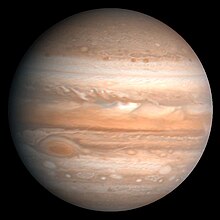Юпитер
Тас көрүҥэ
(Мантан: Сэндэли көстө)
 This image was enhanced by the U.S. Geological Survey to bring out detail. It is based on a 1979 image from the Voyager 1 spacecraft. |
|||||||||||||||||||||||
Designations
| |||||||||||||||||||||||
|---|---|---|---|---|---|---|---|---|---|---|---|---|---|---|---|---|---|---|---|---|---|---|---|
| Adjective | Jovian | ||||||||||||||||||||||
| Epoch J2000 | |||||||||||||||||||||||
| Aphelion | 816 520 800 km (Халыып:Convert/LonAonSoff) | ||||||||||||||||||||||
| Perihelion | 740 573 600 km (Халыып:Rnd/c4dec1 AU) | ||||||||||||||||||||||
| Semi-major axis | 778 547 200 km (Халыып:Rnd/c4dec1 AU) | ||||||||||||||||||||||
| Eccentricity | 0.048775 | ||||||||||||||||||||||
| Orbital period | 4331.572 days 11.85920 yr |
||||||||||||||||||||||
| Synodic period | 398.88 days[3] | ||||||||||||||||||||||
| Average orbital speed | 13.07 km/s[3] | ||||||||||||||||||||||
| Mean anomaly | 18.818° | ||||||||||||||||||||||
| Inclination | 1.305° 6.09° to Sun's equator |
||||||||||||||||||||||
| Longitude of ascending node | 100.492° | ||||||||||||||||||||||
| Argument of perihelion | 275.066° | ||||||||||||||||||||||
| Satellites | 63 | ||||||||||||||||||||||
Физика кээмэйдэрэ
| |||||||||||||||||||||||
| Equatorial radius | 71,492 ± 4 km[4][5] 11.209 Earths |
||||||||||||||||||||||
| Polar radius | 66,854 ± 10 km[4][5] 10.517 Earths |
||||||||||||||||||||||
| Flattening | 0.06487 ± 0.00015 | ||||||||||||||||||||||
| Surface area | 6.21796×1010 km²[6][5] 121.9 Earths |
||||||||||||||||||||||
| Volume | 1.43128×1015 km³[3][5] 1321.3 Earths |
||||||||||||||||||||||
| Mass | 1.8986×1027 kg[3] 317.8 Earths |
||||||||||||||||||||||
| Mean density | 1.326 g/cm³[3][5] | ||||||||||||||||||||||
| Equatorial surface gravity | 24.79 m/s²[3][5] 2.528 g |
||||||||||||||||||||||
| Escape velocity | 59.5 km/s[3][5] | ||||||||||||||||||||||
| Sidereal rotation period |
9.925 h[7] | ||||||||||||||||||||||
| Equatorial rotation velocity | 12.6 km/s 45,300 km/h |
||||||||||||||||||||||
| Axial tilt | 3.13°[3] | ||||||||||||||||||||||
| North pole right ascension | 268.057° 17 h 52 min 14 s[4] |
||||||||||||||||||||||
| North pole declination | 64.496°[4] | ||||||||||||||||||||||
| Albedo | 0.343 (bond) 0.52 (geom.)[3] |
||||||||||||||||||||||
| Surface temp. 1 bar level 0.1 bar |
| ||||||||||||||||||||||
| Apparent magnitude | -1.6 to -2.94[3] | ||||||||||||||||||||||
| Angular diameter | 29.8" — 50.1"[3] | ||||||||||||||||||||||
Атмосферата[3]
| |||||||||||||||||||||||
| Surface pressure | 20–200 kPa[8] (cloud layer) | ||||||||||||||||||||||
| Scale height | 27 km | ||||||||||||||||||||||
| Composition |
|
||||||||||||||||||||||
Юпитер эбэтэр Сэндэли диэн Күнтэн бэhис уонна Күн систематын ордук улахан планетата. Гаас планеталар ахсааннарыгар киирэр.
Былыргыттан дьон планетаны биллэр. Планета ахтыылара античнай митологияларга баар буолаллар. Юпитер 79 аргыстаах, ордук бөдөҥ аргыстар — Ио, Европа, Ганимед уонна Каллисто.
Быһаарыылар
[уларыт | биики-тиэкиһи уларытыы]- ↑ Yeomans, Donald K. HORIZONS System. NASA JPL (13 От ыйын 2006). Тургутулунна 8 Атырдьах ыйын 2007. — At the site, go to the "web interface" then select "Ephemeris Type: ELEMENTS", "Target Body: Jupiter Barycenter" and "Center: Sun".
- ↑ Orbital elements refer to the barycenter of the Jupiter system, and are the instantaneous osculating values at the precise J2000 epoch. Barycenter quantities are given because, in contrast to the planetary centre, they do not experience appreciable changes on a day-to-day basis from to the motion of the moons.
- ↑ 3,00 3,01 3,02 3,03 3,04 3,05 3,06 3,07 3,08 3,09 3,10 3,11 3,12 3,13 Williams, Dr. David R. Jupiter Fact Sheet. NASA (November 16, 2004). Тургутулунна 8 Атырдьах ыйын 2007.
- ↑ 4,0 4,1 4,2 4,3 Seidelmann, P. Kenneth; Archinal, B. A.; A’hearn, M. F.; et.al. (2007). «Report of the IAU/IAGWorking Group on cartographic coordinates and rotational elements: 2006». Celestial Mechanics and Dynamical Astronomy 90: 155–180. DOI:10.1007/s10569-007-9072-y. Проверено 2007-08-28.
- ↑ 5,0 5,1 5,2 5,3 5,4 5,5 5,6 Refers to the level of 1 bar atmospheric pressure
- ↑ NASA: Solar System Exploration: Planets: Jupiter: Facts & Figures
- ↑ Seidelmann, P. K.; Abalakin, V. K.; Bursa, M.; Davies, M. E.; de Burgh, C.; Lieske, J. H.; Oberst, J.; Simon, J. L.; Standish, E. M.; Stooke, P.; Thomas, P. C. Report of the IAU/IAG Working Group on Cartographic Coordinates and Rotational Elements of the Planets and Satellites: 2000. HNSKY Planetarium Program (2001). Тургутулунна 2 Олунньу 2007.
- ↑ Anonymous (March 1983). «Probe Nephelometer». Galileo Messenger (NASA/JPL) (6). Проверено 2007-02-12.
| ||||||||||||||

